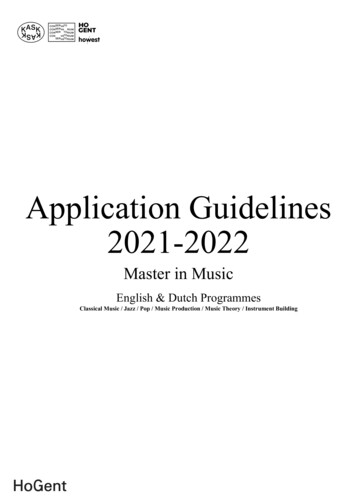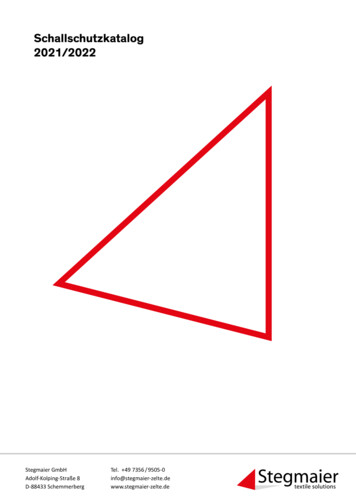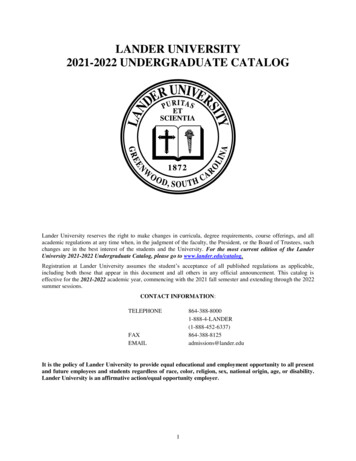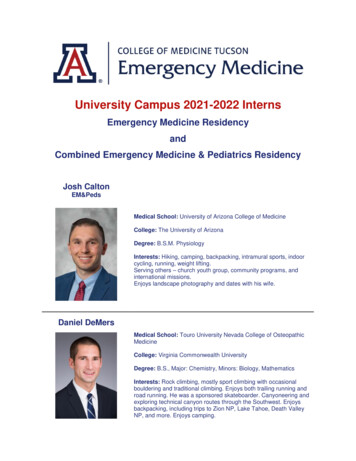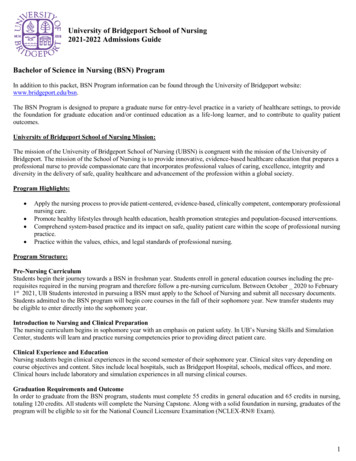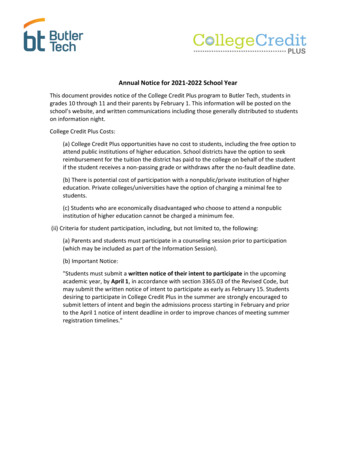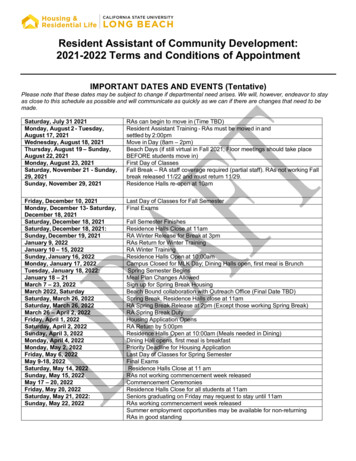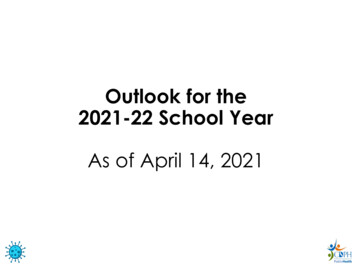
Transcription
Outlook for the2021-22 School YearAs of April 14, 2021
Purpose of this Presentation On April 6, CDPH published Beyond the Blueprint, withthe expected outlook across all sectors. This presentation is intended to provide a more robustschool-specific outlook, in an effort to provide as muchtransparency and lead-time for planning as possible,including:ooo Historical context on where we have beenWhat we have learnedExpected conditions for the next school yearThis presentation includes no directives, guidance, orother policy.2
Where We Have Been What We Learned3
March – May 2020: Schools Close In Response to UncertaintyAbout COVID-19 Risks; Pivot to Distance Learning***4/20**4/1*3/7During this Period: Assumption that children are vectors for COVID-19 and would exacerbate communitytransmission. Uncertainty about how to protect students and staff. Schools pivot as fast as possible to distance learning and supporting families (continued schoolnutrition, providing computing devices, etc.). *March 7: Student tests positive for COVID-19, prompting the state’s fifth largest school districtto announce closure. **April 1: Governor and State Superintendent finalize labor-management framework fordistance learning in partnership with school labor and management groups.***April 20: Governor, First Partner, and State Superintendent secure over 70,000 computing devices and 100,000 connected mobile hotspots from businesses and philanthropies, anddistribute them to schools across the state.4
June – August 2020: Uncertainty Causes Anxious Start to theSchool Year; Schools Focus on Quality Distance Learningand Planning Re-Opening in Red Tier**6/29*6/5During this Period: Understanding and emerging consensus that children are not significant vectors. Continuing uncertainty about most effective mitigation layers: “all of the above” approach(e.g., emphasis on symptom checks because of a lack of scientific understanding ofprevalence of asymptomatic individuals). Schools grapple with two big lifts: (1) quality distance learning and (2) preparing for safe reopenings in Red Tier. With counties in Purple Tier, most schools begin the school year in distance learning andfollow guidance to provide in-person instruction to targeted student groups (e.g., specialeducation) in cohorts. *June 5: California becomes one of the first states to issue comprehensive school reopeningguidance, including a mask mandate in schools. **June 29: Legislature and Governor allocate additional 5.3 billion for schools to respond toCOVID-19, including reopening safeguards and distance learning (e.g., bridging the studentdigital divide). 83% of funds are allocated according to equity metrics (% of low-incomestudents, students with disabilities, etc.). Related legislation (SB 98) also sets requirements fordistance learning, mental health, student re-engagement, and in-person instruction.5
September – November 2020: Safe Re-Opening PlansDelayed by Winter Surge; Schools Contemplate RemainingClosed for the 2020-21 School Year***11/17*9/1 **10/28During this Period: Stronger understanding of effective mitigation layers, including evidence that in-schooltransmission can be near zero with strong implementation of key precautions (e.g., masks). Schools continue improvements to distance learning, but grapple with disengagement andthe mental health of students and staff. Schools continue providing in-person instruction to targeted student groups in cohorts. Schools finalize and begin implementing plans to re-open in Red Tier. Looming Winter Surge associated with the holidays leads to caution, then implementationdelays, then decisions to remain closed for the entire school year. *September 1: Governor’s Office of Emergency Services completes delivery of PPE at no costto schools throughout the state. **October 28: After Governor announces that the State Valencia Branch Laboratory willprioritize COVID-19 testing for schools, HHS publishes Playbook for schools to set up operations. ***November 17: The state’s seventh largest school district announced it would remain closedfor the entire school year. Many school communities contemplate similar decisions.6
December 2020 – March 2021: Strong Public Health Measures toCombat the Surge, Combined with Intensified School Supports,Turns Momentum Back to Reopening***12/30 1/14**12/24*12/3 2/19 3/5During this Period: California experiences a punishing Winter Surge, prompting strong public health measures tocombat transmission. At the height of the Surge, the Governor begins a major push for schoolsto be the first-priority sector to reopen when cases are anticipated to decline in February. *December 3: Governor institutes Regional Stay-at-Home Order. **December 24: California becomes first state to apply for Medicaid reimbursement for schoolCOVID-19 testing, approved by the Biden administration on March 3, 2021. ***December 30: Governor outlines Safe Schools for All Plan, including vaccine prioritization forK-12 staff, State Safe Schools Team for oversight and assistance, comprehensive testing, PPE,and transparency. January 14: Safe Schools for All Hub is launched as a one-stop shop, providing directtechnical assistance to schools and transparency measures for parents. February 19: Governor accelerates vaccines for K-12 school staff, leading to most receivingaccess by early March. March 5: Legislature and Governor allocate additional 6.6 billion to accelerate reopenings and expand mental health and academic supports.7
Expected Conditions forthe 2021-22 School Year8
Major Differences Between Last and Next SchoolYearsKey Factors:1. Research & Understanding2. Oversight & Assistance3. Comprehensive Testing Program4. Vaccines5. Community Transmission9
1. Research & UnderstandingAugust 2020Limitedunderstanding ofrole of children inCOVID-19transmissionTentativeunderstanding ofeffectiveprecautionsSkepticism thatchildren can wearmasksNowBy August 2021Understanding andconsensus that childrenare not major vectorsBetter tailored andtargeted precautionsUnderstanding andconsensus that in-schooltransmission can beminimal with keyprecautionsStrong understanding thatmasks are very effectiveand experience thatchildren can wear themAggressive monitoring ofvariants10Growing evidence ofvaccine effectivenessContinued maskwearing across allagesRobust testing andcontact tracingFurther heightenedfocus on variants
2. Oversight & AssistanceAugust 2020No data on schoolreopening status orcases reported inschoolsReliance on localhealth departmentsState and localhealth departmentsstretched to limits,focused on slowingtransmission andminimizing deathsNowBy August 2021Data on reopening statusand transmissions, amongother elements, availableschool by schoolMore refined andgranular reportingand transparencyCross-agency State SafeSchools Team providingdirect oversight andassistance to hundreds ofschool districtsExpanded StateTeam, includingregional memberscovering everycountyAs adultContact tracingvaccinationsupplemented by routineincreases and othertraining of school liaisons and sectors pose less risk,the School Portal forschools becomeOutbreak Trackingprimary focus11
3. Comprehensive Testing ProgramAugust 2020Substantialbarriers toaccess, includinglimited supplychainsSchool-basedtesting not anoptionNowNation’s most robustschool-based testingprogram, includingboth PCR and antigenoptionsNation’s leadingfinancial supports,including state andfederal funding fortesting for low-incomestudents12By August 2021Between federaland state supports,potential for no-costtesting for schoolsExpanded capacityto support safe inperson instruction atschools
4. VaccinesAugust 2020NowBy August 2021School staff wereoffered vaccinesWith greater supply,throughout the state byaccelerated rise inearly Marchvaccination rates in thefour months untilVaccines40% of CaliforniansAugust, including allseemed like a have received at leasthigh-risk schooldistant hopeone dosecommunity membersand householdsOn April 15, allCalifornians ages 16 Likely vaccine eligibilitywill be eligible forof children ages 12-15vaccines13
5. Community Transmission RatesAugust 2020Many of the mostpopulous counties arein the Purple TierExpectation of a surgeassociated withforthcoming holidaysSchools focus on havinghigh quality distancelearning programsNowNation’s lowestpositivity ratesLowest positivityrates to dateAmongnation’s lowestcase rates14By August 2021Immunity throughpast exposure andvaccination willfurther mitigatecommunitytransmission
Expected Conditions and Next Steps If current trends and best practices continue, the next schoolyear can begin with offering full in-person instruction to allstudents (full days, five days per week). Some staff, students,and families may continue to require accommodations. State health regulations and guidance will remain operative,but will be revised to reflect changing conditions – includingany adjustments to respond to variants – and in consultationwith federal, state, and local partners. Policy decisions about funding, requirements, authorizations,etc. will be enacted by the Legislature and Governor, inconsultation with K-12 stakeholders.15
Planning for the Future Schools can leverage an historic level of state and federalfunds, including 4.6 billion to expand learning opportunities,made available through early action in March. The following should be considered as priorities:o Summer programming, including in partnership withservice providers who can help supplement school staffrecovering from the stress of this school year.o Planning to offer full in-person instruction to all students tostart the next school year.o Communicating with and educating families who may bereluctant to return to in-person instruction.o Maximizing the amount of instructional time, through anextended school year and/or before/after school.o Maximizing the value of instructional time, throughexpanded mental health services and high-doseacademic interventions, such as tutoring.16
school districts Contact tracing supplemented by routine training of school liaisons and the School Portal for Outbreak Tracking More refined and granular reporting and transparency Expanded State Team, including regional members covering every county As adult vaccination increases and other


